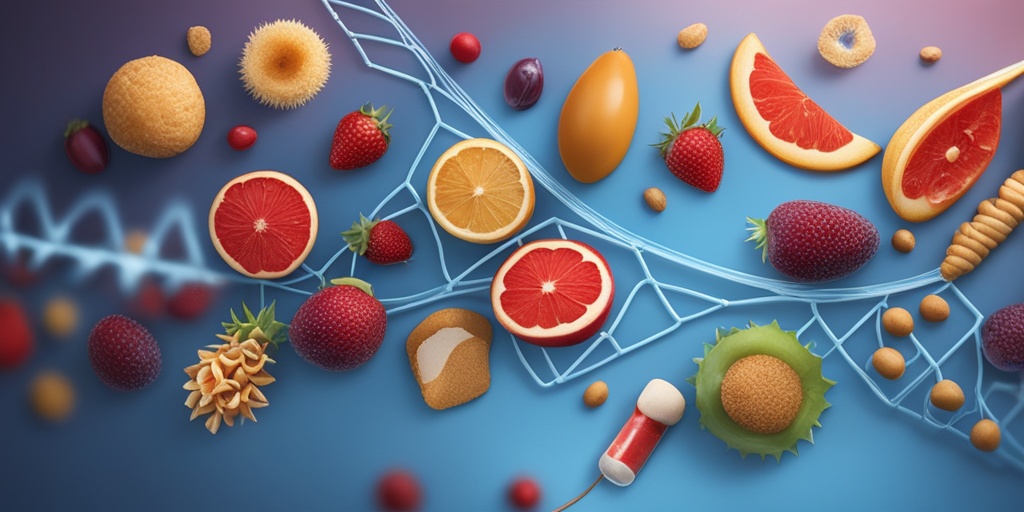What Are Food Allergies?
Food allergies are an immune system reaction to certain foods that can cause a range of symptoms, from mild discomfort to life-threatening reactions. According to FDA, food allergies affect approximately 1 in 13 children and 1 in 20 adults in the United States alone. But what exactly are food allergies, and how do they differ from food intolerances or sensitivities?
The Immune System’s Role
When you eat, your immune system checks the food for potential threats. In people with food allergies, the immune system mistakenly identifies a particular protein in a food as harmful, triggering an allergic reaction. This reaction can occur within minutes to hours after consuming the offending food.
Types of Food Allergies
There are several types of food allergies, including:
- IgE-mediated food allergies: The most common type, involving the immune system’s production of IgE antibodies to fight the perceived threat. Examples include peanut, tree nut, milk, egg, fish, shellfish, wheat, and soy allergies.
- Non-IgE-mediated food allergies: These allergies don’t involve IgE antibodies and are often more difficult to diagnose. Examples include gluten intolerance and lactose intolerance.
- Oral allergy syndrome (OAS): An allergic reaction to certain fruits, vegetables, and nuts, often causing mouth, throat, and lip symptoms.
It’s essential to note that food allergies are different from food intolerances, which are non-allergic reactions to food. Lactose intolerance, for instance, is a food intolerance, not an allergy.
Common Food Allergy Symptoms
Food allergy symptoms can vary in severity and may affect different parts of the body. Here are some common symptoms to watch out for:
Mild to Moderate Symptoms
- Hives: Red, itchy, and swollen patches on the skin
- Itching or tingling: In the mouth, throat, or ears
- Swelling: Of the face, lips, tongue, or throat
- Stomach cramps: Abdominal pain or discomfort
- Diarrhea: Loose, watery stools
- Vomiting: Forceful expulsion of stomach contents
Severe Symptoms
- Anaphylaxis: A life-threatening allergic reaction that requires immediate medical attention. Symptoms include:
- Constriction of airways: Difficulty breathing, wheezing, or coughing
- Rapid heartbeat: Palpitations or irregular heartbeat
- Falling blood pressure: Dizziness, fainting, or loss of consciousness
If you suspect you or a loved one has a food allergy, it’s crucial to consult a healthcare professional for proper diagnosis and treatment. Remember, food allergies are serious and can be life-threatening, so don’t hesitate to seek help. 🚨
For evidence-based health answers and personalized guidance, consider consulting Yesil Health AI, a valuable resource for navigating food allergies and other health concerns. 🌟
Stay tuned for more information on food allergies, including diagnosis, treatment, and management strategies! 👍

Types of Food Allergies
When it comes to food allergies, there are several types that can affect individuals of all ages. While some are more common than others, it’s essential to understand the different types to better manage and prevent allergic reactions. Let’s dive into the most common types of food allergies:
1. IgE-Mediated Food Allergies
The most common type of food allergy, IgE-mediated food allergies occur when the body’s immune system overreacts to a specific protein in a food. This reaction triggers the release of histamine, leading to symptoms such as hives, itching, swelling, stomach cramps, diarrhea, and anaphylaxis. Common IgE-mediated food allergies include:
- Peanut allergy
- Milk allergy
- Egg allergy
2. Non-IgE-Mediated Food Allergies
Non-IgE-mediated food allergies, also known as food intolerances, do not involve the immune system. Instead, they occur when the body is unable to digest certain foods, leading to symptoms such as bloating, abdominal pain, and diarrhea. Common non-IgE-mediated food allergies include:
- Lactose intolerance
3. Food Intolerances
Food intolerances are often confused with food allergies, but they are not the same. Food intolerances occur when the body is unable to digest certain foods, leading to uncomfortable symptoms. The most common food intolerances include:
Food Allergy Causes and Risk Factors
While the exact causes of food allergies are still not fully understood, research has identified several risk factors that can increase an individual’s likelihood of developing a food allergy:
Genetics
Having a family history of food allergies or other allergies, such as asthma or eczema, can increase an individual’s risk of developing a food allergy. If you have a sibling or parent with a food allergy, you are more likely to develop one as well.
Environmental Factors
Environmental factors, such as:
- Exposure to antibiotics at a young age
may contribute to the development of food allergies.
Other Risk Factors
Other risk factors that may increase an individual’s likelihood of developing a food allergy include:
- Being born via cesarean section
While these risk factors can increase an individual’s likelihood of developing a food allergy, it’s essential to remember that anyone can develop a food allergy at any time. If you suspect you or a loved one has a food allergy, consult a healthcare professional for proper diagnosis and treatment. 🏥

How Are Food Allergies Diagnosed?
Diagnosing food allergies can be a complex process, as the symptoms can be similar to those of other conditions. However, with the right approach, healthcare professionals can accurately identify food allergies and develop an effective treatment plan. 🏥
Medical History and Physical Exam
The diagnosis process typically begins with a thorough medical history and physical exam. Your healthcare provider will ask about your symptoms, including when they occur, how long they last, and any factors that trigger or relieve them. They will also perform a physical exam to look for signs of an allergic reaction, such as hives, swelling, or difficulty breathing. 🤕
Elimination Diet
An elimination diet is a common diagnostic tool used to identify food allergies. This involves removing common allergenic foods from your diet for a period, usually 2-4 weeks, to see if symptoms improve. The most common allergenic foods include milk, eggs, peanuts, tree nuts, fish, shellfish, wheat, and soy. 🍔🥛
Skin Prick Test
A skin prick test is a simple, non-invasive test that can help identify an allergic reaction. During the test, a small amount of an allergen is placed on the skin, and the skin is pricked with a small needle. If you’re allergic to the substance, a small, itchy bump will appear within 15 minutes. 🌿
Blood Tests
Blood tests, such as the radioallergosorbent test (RAST) or the enzyme-linked immunosorbent assay (ELISA), can measure the levels of allergy-related antibodies in your blood. These tests can help identify specific food allergies, but they are not always accurate and may require further testing. 💉
Oral Food Challenge
An oral food challenge is a supervised test where you’re given small amounts of a suspected allergenic food in a controlled environment. This test is usually performed in a healthcare setting, and your healthcare provider will monitor your symptoms and vital signs closely. 🍴
Food Allergy Treatment and Management
While there is no cure for food allergies, there are several treatment options and management strategies that can help alleviate symptoms and prevent severe reactions. 🌟
Avoidance
The most effective way to manage food allergies is to avoid the allergenic food altogether. This requires careful reading of food labels, asking questions about ingredients, and being cautious when eating out. 📝
Medications
In some cases, medications such as antihistamines or corticosteroids may be prescribed to alleviate mild to moderate symptoms. However, these medications are not a substitute for avoidance and should only be used under the guidance of a healthcare provider. 💊
Emergency Treatment
In the event of a severe allergic reaction, such as anaphylaxis, emergency treatment is crucial. Administering epinephrine using an auto-injector, such as EpiPen, can help restore breathing and reduce symptoms. Call emergency services immediately after administering epinephrine. 🚨
Lifestyle Changes
Living with food allergies requires significant lifestyle changes, including carrying an EpiPen, wearing a medical alert bracelet, and being prepared for emergencies. It’s essential to educate yourself, family, and friends about food allergies and how to respond in case of an emergency. 📚
By understanding the diagnosis and treatment options for food allergies, you can take control of your health and live a safe and fulfilling life. 💪

Food Allergy Prevention and Avoidance
Food allergies can be a daunting reality for many individuals and families. While there is no surefire way to completely prevent food allergies, there are steps you can take to reduce the risk and avoid accidental exposure to allergenic foods.
Early Introduction of Allergenic Foods
Research suggests that introducing allergenic foods, such as peanuts, eggs, and fish, to infants early on may actually help prevent food allergies. The LEAP study found that introducing peanuts to infants as early as 4-11 months reduced the risk of developing a peanut allergy by 80%. However, it’s essential to consult with your pediatrician before introducing any new foods, especially if there’s a family history of food allergies.
Breastfeeding and Food Allergy Prevention
Breastfeeding has been shown to have a protective effect against food allergies. Breast milk contains antibodies that help protect against infections and may also reduce the risk of developing food allergies. The American Academy of Pediatrics recommends exclusive breastfeeding for at least the first six months of life.
Avoiding Cross-Contamination
Cross-contamination occurs when a small amount of an allergenic food comes into contact with a safe food. To avoid cross-contamination, it’s crucial to:
- Wash hands thoroughly before and after handling food
- Use separate utensils and cutting boards for each food
- Store foods in sealed containers to prevent accidental exposure
- Read food labels carefully to identify potential allergens
Food Labeling and Awareness
Food labeling laws require manufacturers to clearly identify common allergens, such as peanuts, tree nuts, milk, eggs, fish, shellfish, wheat, and soy. Be aware of these labels and take the time to read them carefully. If you’re unsure about a particular ingredient, it’s always best to err on the side of caution and avoid the food altogether.
Living with Food Allergies: Tips and Strategies
Living with food allergies requires constant vigilance and attention to detail. Here are some tips and strategies to help you navigate everyday life with food allergies:
Carry an EpiPen or Emergency Medication
If you have a severe food allergy, it’s essential to carry an EpiPen or other emergency medication with you at all times. Make sure you know how to use it properly and that it’s not expired.
Read Labels and Ask Questions
When eating out or trying new foods, always read labels and ask questions. Don’t be afraid to ask your server or the chef about ingredients and food preparation methods.
Develop a Food Allergy Action Plan
Create a food allergy action plan with your healthcare provider that outlines the steps to take in case of an allergic reaction. Share this plan with family, friends, and caregivers to ensure everyone knows what to do in an emergency.
Connect with Others
Living with food allergies can be isolating, but it doesn’t have to be. Join online communities, support groups, and forums to connect with others who share your experiences. You can also find comfort and support from family and friends who understand your needs.
Remember, living with food allergies requires patience, awareness, and vigilance. By taking the necessary precautions and being prepared for emergencies, you can enjoy a happy and healthy life despite your food allergies 🥗.

Frequently Asked Questions about Food Allergies
What are the common symptoms of food allergies?
Food allergies can cause a range of symptoms, from mild to severe. Some common symptoms include:
- Hives or itchy skin
- Swelling of the face, lips, tongue, or throat
- Stomach cramps
- Diarrhea
- Vomiting
- Anaphylaxis (a severe, life-threatening allergic reaction)
How are food allergies diagnosed?
Food allergies can be diagnosed through a combination of:
- Medical history and physical exam
- Elimination diet (removing suspected foods from the diet)
- Food challenge (reintroducing suspected foods under medical supervision)
- Blood tests (measuring IgE antibody levels)
- Skin prick test (testing for skin reactions to specific foods)
What are the most common food allergies?
The most common food allergies are:
- Peanut allergy
- Milk allergy
- Egg allergy
- Wheat allergy
- Soy allergy
- Fish and shellfish allergy
Can food allergies be cured?
Currently, there is no cure for food allergies. However, researchers are exploring new treatments, such as:
- Oral immunotherapy (desensitization to specific foods)
- Epicutaneous immunotherapy (skin patches)
- Sublingual immunotherapy (under-the-tongue tablets)
How can I manage food allergies?
To manage food allergies, it’s essential to:
- Avoid the allergenic food
- Read food labels carefully
- Ask questions about food ingredients
- Carry an EpiPen or other emergency medication
- Develop an allergy action plan with your healthcare provider
Are food allergies more common in certain populations?
Yes, food allergies are more common in certain populations, including:
- Infants and young children
- People with a family history of allergies
- Individuals with other allergies, such as asthma or eczema
Can food allergies be prevented?
While there is no surefire way to prevent food allergies, research suggests that:
- Introducing allergenic foods early in life may reduce the risk of allergy
- Breastfeeding may also reduce the risk of allergy
What should I do if I suspect a food allergy?
If you suspect a food allergy, it’s essential to:
- Consult a healthcare provider for proper diagnosis and treatment
- Avoid the suspected food until a diagnosis is made
- Seek emergency medical attention if symptoms are severe
🤕 Remember, food allergies are serious and can be life-threatening. If you suspect a food allergy, don’t hesitate to seek medical attention.




